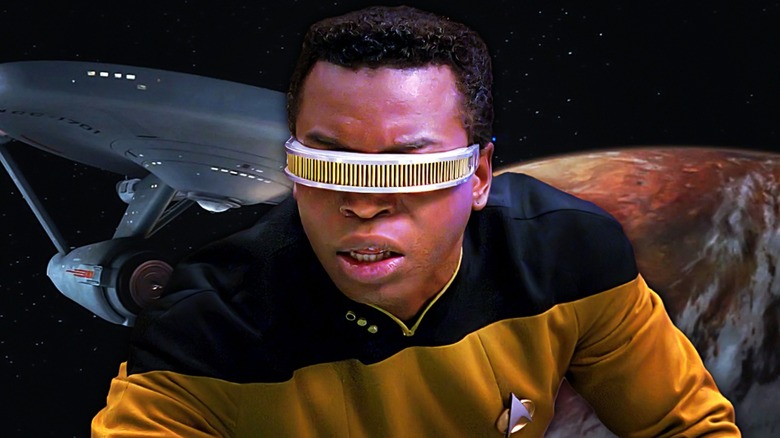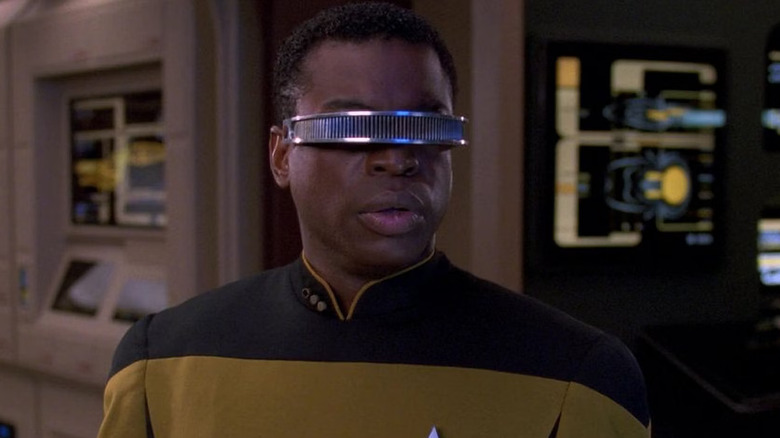[ad_1]
Uno de los aspectos más esperanzadores de la tremendamente optimista serie Star Trek es que todas las discapacidades podrán adaptarse más fácilmente en el futuro. Aunque algunos podrían afirmar que las tecnologías milagrosas disponibles en Star Trek podrían solucionar cualquier discapacidad, su uso plantearía cuestiones éticas espinosas para la audiencia. ¿Cuántas discapacidades “corregirán” los escritores de Star Trek antes de que la serie empiece a oler a eugenesia?
En cambio, cualquier persona con discapacidad recibe un dispositivo o prótesis que le permite funcionar en la Flota Estelar sin que nadie cause problemas. Por ejemplo: Geordi La Forge, el ingeniero interpretado por LeVar Burton En “Star Trek: La próxima generación” Geordie nació ciega, sin iris ni pupila. Para poder ver, Jordi lleva un dispositivo sobre los ojos llamado VISOR, que está vinculado a pequeños sensores neuronales implantados en sus sienes. VISOR recibe información visual y la envía directamente al cerebro de Jordi, sin pasar por sus globos oculares. Su visión es mayoritariamente térmica, lo que le da a Geordi un tipo de información visual diferente al de la mayoría de las personas.
En algunos de los primeros episodios de “The Next Generation”, los personajes discuten cómo funciona el dispositivo VISOR de Geordi, pero después de un rato, todos dejan de mencionarlo. Era sólo una parte del espectáculo. De hecho, en las raras ocasiones en que un dignatario visitante le preguntaba a Gord sobre su VISOR, él se enojaba, del mismo modo que alguien podría enfadarse cuando le hicieran preguntas personales sobre su silla de ruedas.
Pero en el set de “The Next Generation”, el dispositivo de visión nocturna tuvo el efecto contrario. El dispositivo de visión nocturna que Burton tuvo que usar oscureció gran parte de su visión, lo que hizo que algunas de sus escenas fueran difíciles de interpretar. Burton también tuvo que aprender a actuar sin ojos, lo que supuso un gran desafío para cualquier actor. En 2007, En una entrevista con BBC TwoBurton habló sobre el uso de su máscara protectora durante el rodaje y lo describió como “un infierno”.
un infierno viviente
LeVar Burton ocupó la mayor parte de la primera temporada del programa en 1987. Burton era consciente de que este dispositivo imaginario, que se decía que mejoraba la visión pero que en realidad la oscurecía, no pasó desapercibido para Burton. Dijo:
“Es un verdadero infierno. Perdí entre el 85 y el 90 por ciento de mi visión cuando llevaba una máscara protectora. En la primera temporada choqué con todo; los soportes de luz, los micrófonos del techo, los cables a mis pies. Esto es como un dilema. El ciego que usa una máscara protectora y ve mucho más que nadie a su alrededor, cuando el actor realmente hace eso, se convierte en una persona ciega”.
Se podría suponer que la mascarilla era un dispositivo liviano que estaba pegado con cinta adhesiva a las sienes de Burton. Puede que eso haya sido cierto para la primera temporada, pero a los maquilladores se les ocurrió algo aún más convincente (y más conmovedor) para la segunda temporada. La nueva mascarilla era una pieza de metal que estaba adherida a las sienes de Burton y presionada firmemente contra su cabeza. Puede que permaneciera inmovilizado, pero Burton notó que después de un largo día de filmación, empezaba a doler. Continuó:
“Para la temporada 2, rediseñamos la mascarilla y la hicimos más pesada, y la forma en que la colocamos fue atornillándola, literalmente la atornillamos en mi cabeza, así que había tornillos que estábamos girando y había bordes. el lado interno que presionaba mis sienes. Entonces, después de quince o veinte minutos de eso, tuve dolor de cabeza todos los días durante unos seis años, lo cual tampoco fue divertido”.
A Burton no se le concedió una exención para usar el dispositivo VISOR hasta su aparición en “Star Trek: First Contact” en 1996. Para entonces, se habían inventado globos oculares mecánicos que funcionaban y se implantaron un par de ellos en el ojo de Geordi. Uno sólo puede imaginar lo aliviado que se sintió Burton después de una década de dolor.
[ad_2]
Source Article Link





